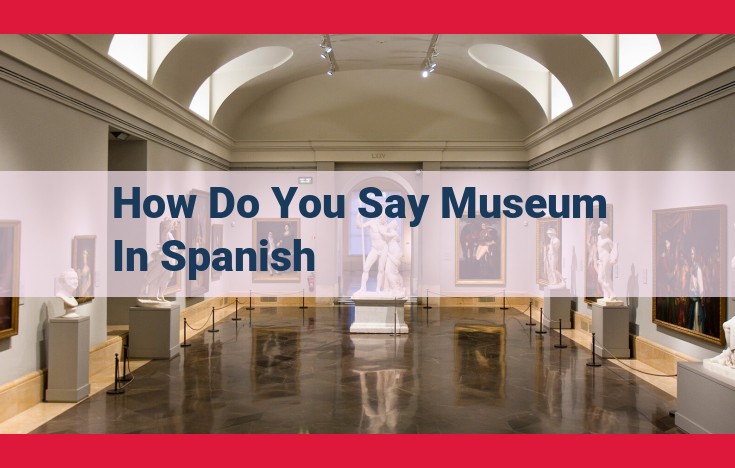
Unveiling The True Meaning Of “Museo”: A Journey From Greek To Spanish
To say "museum" in Spanish, use the word "museo." It's derived from the Greek word "mouseion," referring to institutions dedicated to the arts and sciences.
Core Entities: Museums
- Definition and etymology of the term "museum"
- Types of museums based on their primary focus
Unlocking the Wonders of Museums
Museums, enigmatic repositories of human history and creativity, have captured our fascination for centuries. From the ancient Greek word mouseion, meaning a place dedicated to the Muses, the concept of a museum has evolved into a multifaceted institution that preserves and showcases the tapestry of human knowledge and artistry.
Types of museums are as diverse as the subjects they explore. Art museums house a vast array of paintings, sculptures, and other visual masterpieces. Natural history museums delve into the intricate web of life on Earth, from tiny insects to colossal dinosaurs. Science museums ignite our curiosity about the physical world, showcasing cutting-edge technologies and interactive exhibits. History museums transport us through time, offering a glimpse into the events and figures that have shaped our present.
Within these broad categories, specialized museums cater to specific interests. Pinotecas focus exclusively on paintings, while galleries exhibit a wider range of art forms. Science museums may specialize in fields such as physics, chemistry, or astronomy. History museums can explore a particular era, region, or theme.
The core components of a museum ensure the preservation and presentation of its treasures. Conservators, the guardians of museum artifacts, meticulously care for and restore these objects. Exhibitions, the heart of a museum's storytelling, display carefully curated collections that engage and educate visitors. Collections, the lifeblood of a museum, comprise the vast array of artifacts and specimens that are acquired, cataloged, and preserved for future generations. Artworks, individual pieces of artistic genius, are the central focus of many museum exhibits.
Through their diverse collections and engaging exhibitions, museums offer a window into the human experience. They inspire awe, provoke thought, and foster a deeper understanding of our world and our place within it.
Major Categories of Museums: Exploring the Diverse World of Collections
Museums, sanctuaries of heritage and knowledge, come in a kaleidoscope of forms, each tailored to specific realms of human ingenuity and history. Among the vast tapestry of museums, two primary categories emerge:
A. Types of Museums:
-
Pinoteca: Delving into the enigmatic realm of paintings, pinotecas showcase the captivating narratives and vibrant hues of the canvas. These museums are dedicated to the preservation and exhibition of paintings, offering an intimate encounter with the brushstrokes of masterful artists.
-
Gallery: Galleries embrace a broader spectrum of artistic expression, encompassing not only paintings but also sculptures, photographs, and installations. They serve as platforms for contemporary art, allowing visitors to engage with the latest trends and cutting-edge creations.
B. Specialized Museums:
-
Science Museums: Embarking on a journey of discovery, science museums ignite curiosity about the wonders of the natural world. They showcase scientific phenomena, technological advancements, and the intricate workings of the cosmos. Interactive exhibits and hands-on demonstrations bring science to life, fostering a deeper understanding of the universe.
-
History Museums: Delving into the annals of time, history museums serve as guardians of our collective past. They preserve and exhibit artifacts, documents, and relics that tell the compelling stories of civilizations, cultures, and the transformative moments that have shaped our world. History museums connect us to our roots, allowing us to appreciate the legacies of those who came before us.
These categories of museums provide a glimpse into the boundless world of human achievement, creativity, and historical significance. Whether your passion lies in the captivating beauty of art or the awe-inspiring marvels of science and history, museums offer an extraordinary journey of exploration and enlightenment.
Unveiling the Intricate Components of a Museum
Conservator: The Guardians of History's Treasures
Within the hallowed halls of museums reside individuals known as conservators, the unsung heroes dedicated to safeguarding museum artifacts. These dedicated professionals possess a keen eye for detail and an immense knowledge of preservation techniques. Their meticulous care ensures that precious relics, from ancient fossils to exquisite paintings, retain their integrity for generations to come.
Exhibition: A Window into the Past and Beyond
Exhibitions are the heart and soul of a museum, captivating visitors with an immersive journey through various realms. They meticulously display museum items, inviting patrons to admire priceless artworks, delve into historical timelines, or witness scientific marvels firsthand. Each exhibition becomes a storybook, transporting us to different eras, cultures, and discoveries.
Collection: A Tapestry of Time and Culture
The collection is the beating heart of any museum, an ever-growing repository of objects that tell a multifaceted narrative of human existence. Through tireless efforts, museums acquire, catalogue, and preserve these treasures, ranging from rare manuscripts to technological marvels. Each object holds a unique tale, adding to the collective tapestry of our shared heritage.
Artwork: Embracing the Power of Expression
Artwork, in its myriad forms, adorns the walls of museums, inviting us to contemplate the boundless creativity of human imagination. From awe-inspiring paintings to delicate sculptures, each artwork carries a story, a glimpse into the mind of its creator. It awakens our senses, stirs our emotions, and expands our understanding of the world around us.
Related Topics:
- Antietam: Unraveling The Pronunciation, History, And Significance In American Civil War
- Understanding Remorse: A Path To Reconciliation And Healing
- Spanish Greetings: Navigating Formal And Informal Options Based On Gender, Closeness, And Culture
- Master The Pronunciation Of “Amortization” With This Simple Guide
- Seo-Optimized Title:puerto Rican Spelling Mastery: A Comprehensive Guide To Proper Orthography